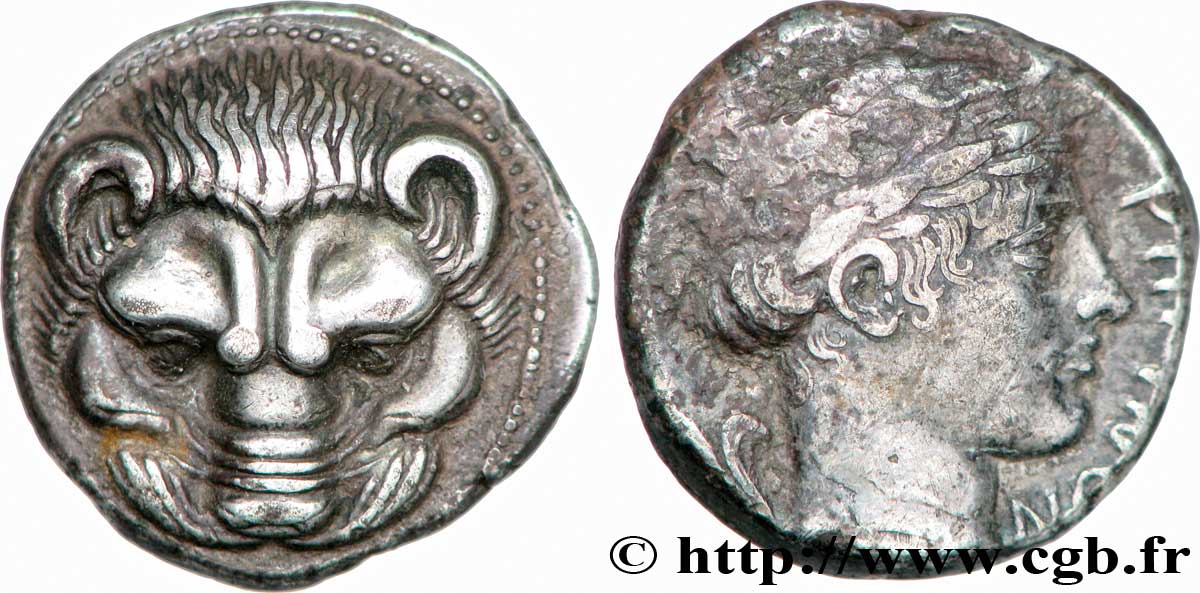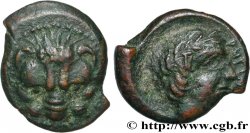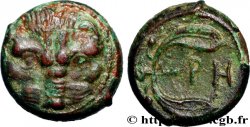v57_0012 - BRUTTIUM - REGGIO Tétradrachme
MONNAIES 57 (2013)
Starting price : 5 500.00 €
Estimate : 9 500.00 €
unsold lot
Starting price : 5 500.00 €
Estimate : 9 500.00 €
unsold lot
Type : Tétradrachme
Date: c. 415/410 - 387 AC.
Mint name / Town : Rhégium, Bruttium
Metal : silver
Diameter : 23 mm
Orientation dies : 6 h.
Weight : 16,91 g.
Rarity : R3
Coments on the condition:
Exemplaire sur un petit flan épais, parfaitement centré des deux côtés d’un style fantastique, de très haut relief avec un masque de lion extraordinaire, semblant sortir du flan. Revers finement détaillé de haut relief, un peu court sur la légende avec un visage expressif d’une émotion profonde et émouvante. Très belle patine de médaillier avec des reflets dorés
Catalogue references :
Predigree :
Cet exemplaire provient de la vente Vinchon du 17 décembre 1996, n ° 15
Obverse
Obverse legend : ANÉPIGRAPHE.
Obverse description : Masque de lion vu de face ; grènetis perlé circulaire.
Reverse
Reverse description : Tête laurée d’Apollon à droite, la chevelure élégamment disposée ; derrière un rameau d’olivier avec deux feuilles.
Reverse legend : RHGINON
Reverse translation : (de Rhégium).
Commentary
Mêmes coins que l’exemplaire du Cabinet des médailles de la BnF, collection de Luynes, n° 794 et que l’exemplaire de la collection Valton, n° 108 que l’exemplaire de la collection Montagu (Sotheby, 1896), n° 81 que l’exemplaire du British Museum, collection Payne Knight et que celui du Fitzwilliam Museum de Cambridge (SNG. n° 849). C’est le dixième exemplaire recensé. Il pourrait s’agir de l’exemplaire signalé dans le commerce en 1949 (Dr. Jacob Hirsch), mais nous n’avons pas d’indication de poids. En dehors de l’exemplaire du British Museum qui pèse 16,76 g, tous les autres exemplaires ont un poids supérieur (entre 17,18 g et compris jusqu’à 17,40 g). Nous n’avons pas de liaison de coin avec d’autres exemplaires de la série. Il s’agit de l’ultime tétradrachme du classement de Herzfelder avant la destruction de la cité par Denys l’Ancien en 387 avant J.-C.
Same dies as the example in the Cabinet des médailles of the BnF, Luynes collection, no. 794 and the example in the Valton collection, no. 108, as the example in the Montagu collection (Sotheby, 1896), no. 81, as the example in the British Museum, Payne Knight collection and that of the Fitzwilliam Museum in Cambridge (SNG. no. 849). This is the tenth example recorded. It could be the example reported in trade in 1949 (Dr. Jacob Hirsch), but we have no indication of weight. Apart from the example in the British Museum which weighs 16.76 g, all the other examples have a higher weight (between 17.18 g and up to 17.40 g). We have no die connection with other examples in the series. This is the last tetradrachm in Herzfelder's classification before the destruction of the city by Dionysius the Elder in 387 BC.
Same dies as the example in the Cabinet des médailles of the BnF, Luynes collection, no. 794 and the example in the Valton collection, no. 108, as the example in the Montagu collection (Sotheby, 1896), no. 81, as the example in the British Museum, Payne Knight collection and that of the Fitzwilliam Museum in Cambridge (SNG. no. 849). This is the tenth example recorded. It could be the example reported in trade in 1949 (Dr. Jacob Hirsch), but we have no indication of weight. Apart from the example in the British Museum which weighs 16.76 g, all the other examples have a higher weight (between 17.18 g and up to 17.40 g). We have no die connection with other examples in the series. This is the last tetradrachm in Herzfelder's classification before the destruction of the city by Dionysius the Elder in 387 BC.








 Report a mistake
Report a mistake Print the page
Print the page Share my selection
Share my selection Ask a question
Ask a question Consign / sell
Consign / sell
 Full data
Full data









